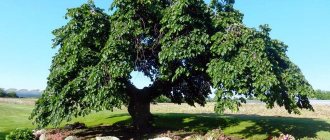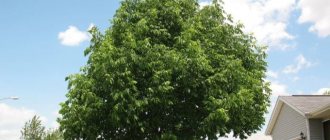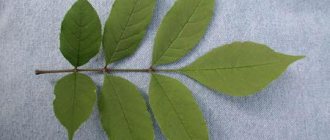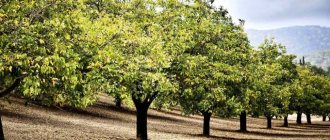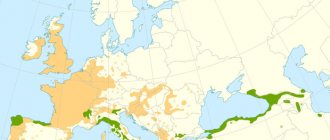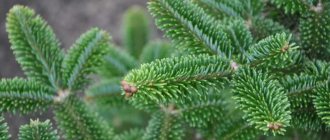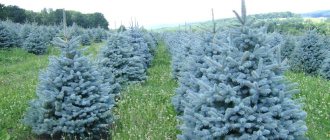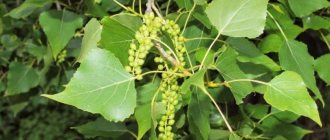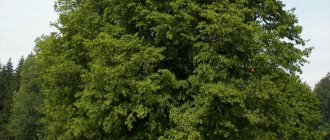Botanical description
It is represented by a plant with an evergreen crown, growing in the form of shrubs and trees. Cypress trees are members of the Cypress family. The crop, depending on the variety, takes on different crown shapes - spreading or even. It is considered a century-old tree, since the lifespan of individual individuals can exceed three centuries. The height of cypress trees can exceed 25 m, while shrubs grow up to 2 meters. Tree growth activity is observed in the first years of life; adult plants grow slowly.
The roots are spreading and dense. The rhizome lies to a depth of 2 meters in the ground. Young individuals have a small rhizome with an abundance of adventitious roots. The diameter of the main roots of an adult cypress reaches 15 cm. The roots are light inside, covered with a brown layer on top.
Depending on the form of growth, cypress may have one trunk or several stems growing from the base of the rhizome. The trunk can be erect or curved, covered with gray-brown bark. The bark of young plants is smooth, lighter than that of adult plants. With age, the trunks darken and develop vertical cracks on the stems and trunk. The tree trunk is about 1 meter in diameter, but there are patriarchs with a diameter exceeding 5 meters. At a distance of about a meter from the base, additional branches extend from the trunk. The trees have a variety of shapes - from pyramidal to spreading weeping. The branches decrease in size as they reach the top. The diameter of the crown at the bottom of the tree can reach 5 meters, and at the top it is about a meter. The branches are fluffy, covered with smaller branches and shoots.
The stems of the shrubs are dark brown in color and covered with smooth bark. Shrubs have several stems. The branches are spreading and have an abundance of accessory branches and stems. The branches are covered with small scales, giving the bush volume. The stems are covered with smaller branches, densely covering the entire bush.
Over the entire surface, the cypress is densely covered with a green crown, consisting of many needles. Needles are needle-like leaves that cover every branch and shoot of the plant. Young trees have needle-like leaves that darken and become scaly over time. The leaves of mature cypress trees are pressed against the branches, forming a dense surface. There is a groove visible on the outer part of the leaves, which is an oil gland. The color of the leaves is green or green-blue. The leaves of the bush are embossed and quite long. The length of the thin plate can exceed 5 cm. On the stems, soft needles are supported by a modified petiole, which forms part of a leaf narrowed at the base. The peculiarity is that the leaves can be divided into several parts.
In spring, male and female cones appear on the plant. The culture is monoecious, with fruits of different sexes appearing in different parts of the cypress. male cones - microstrobiles, are small growths hanging down from the shoots. At the end of the male cone there is a spore-bearing leaf. Males are arranged in several units. The females are located close to the males so that pollination can take place. The female cones are much larger and are attached to the stem with a small rod. The cones are scaly, under the top layer the seeds are tightly pressed to the center. An unripe cone is tightly sealed, but as it ripens, it opens and scatters nuts throughout the area. The shape of female cones is ovoid, color is brown.
Microbiota is one of a kind
Among the cypress trees there is a truly unique plant - cross-paired microbiota. It alone represents a genus of microbiota and is found only in the highlands of Sikhote-Alin in the Far East. This exclusivity and reduction in range became the reason for its inclusion in the Red Book of Russia. The plant, discovered less than a century ago, is the focus of gardeners' attention. The microbiota grows on rocky soils; the upward growth rate is slow, but it spreads well in breadth. It forms a dense pillow on which you can lie down as an experiment. Microbiota is found in rock gardens and is convenient as a ground cover plant. In winter it darkens, acquiring shades of bronze and copper.
Cypress trees combine the evergreen beauty of conifers and enrich it with their diversity.
offers landscaping and landscaping services - we have high quality and reasonable prices.
Spreading
Cypress trees in the wild grow in subtropical and tropical temperatures. Plants are heat-loving, so wild crops do not live in temperate climates. However, today several indoor varieties and hybrids have been bred and are actively grown in northern latitudes.
The habitat is considered to be North America, the Caucasus, the Sahara and the Himalayas. Wild specimens are native to China and Oregon. You can also grow wild cypress trees in Russia - in Crimea and Sevastopol. The plant's habitat is the Mediterranean. The cultures are found throughout Syria and Libya. Hybrid varieties are grown everywhere.
Cypress trees are heat-loving crops that grow in the wild along the edges of rivers and coastal areas. The plant is cultivated in the form of alleys, as well as individual ornamental trees. The crop is not picky about the soil; fertility and a sufficient amount of nutrients are not important for it.
Content
- 1. Description 1.1. Popular varieties and varieties
Cypress belongs to the Cypress family (Cupressaceae). The genus includes 14 species of evergreen trees and shrubs.
In the ancient world, Cypress was considered the tree of death and was dedicated to the deities of the underworld. Cypress branches were used by the Hellenes and Romans in ritual mourning ceremonies. In Christian symbolism, the plant, on the contrary, personifies eternal life and rebirth. According to one version, it was from Cupressus that Noah made his ark.
Originates from California, distributed throughout the Northern Hemisphere, in warm temperate climates.
Types and varieties of cypress
Cypress has about 30 varieties. In addition, today several different varieties of plants have been bred that are more resistant to temperate climate conditions and can grow in an indoor environment.
Arizona cypress cupressus arizonica
A fairly frost-resistant plant that grows in the form of trees, up to 20 meters high. The plant has a spreading crown, with a diameter at the base reaching 5 meters. The culture is quite unpretentious in care. The peculiarity of the tree is that the bark peels off as the crop matures.
The leaves of this species are imbricated, covered with grayish foliage, tightly adjacent to the base of the tree. The abundance of branches gives the crop a fluffy appearance. In spring, cones appear on the plant, which have a purple-blue tint. The foliage of this species has pointed edges. As they ripen, the fruits become brown. The cones are located almost vertically, on dense stalks.
Evergreen cypress cupressus sempervirens
A tree whose height reaches 30 meters. The plant has an even pyramidal shape, therefore it is valued as an ornamental plant. The branches of the tree are pressed tightly against the bark and have an ascending growth pattern. The leaves have dark green shades. The foliage fits tightly to the stem.
The tree trunk is quite narrow, rarely exceeding half a meter in diameter. This structure makes cypress vulnerable to strong winds and drafts. In spring, cones appear on young shoots. The monoecious plant ripens by early autumn, releasing about 20 seeds from its female brown, rounded cone. The fruits are located vertically on the plant, attached to the base by a petiole.
Lusitanian cypress or Mexican cupressus lusitanica
The habitat of the culture is the middle zone of America. The plant is a giant, the height of the tree can reach 50 m. A feature of the culture is considered to be the reddish tint of the bark. Unlike other species, cypress has a spreading crown, which begins to form from the base of the tree. The diameter of the crown at the base of the crop often exceeds 5 meters. The horizontal branches on the trunk are located quite close to each other, so the crown of the tree is very dense and creates good shade in sunny weather. Old trees lower their branches almost to the ground.
Mexican cypress leaves are dark green. The foliage is densely located on all branches, forming a dense tent. The leaves are scaly and press closely to the shoots. The culture, despite its size, is thermophilic and does not tolerate frost well.
Kashmir cypress cupressus cashmeriana
The plant is native to Spain and the Himalayas. They are giants, up to 45 m in height, shaped like an even cone. Despite the height, the diameter of the trunk rarely exceeds 70 cm. The appearance of the plant is decorative, due to the crown forming a narrow cone. The leaves are narrow, needle-shaped in young trees, changing to scaly in shape in mature trees. The foliage is colored bluish.
You might be interested in: Belena
Cashmere cypress does not tolerate frost well, but it easily adapts to drought and prolonged heat. The plant grows quickly and is easily tolerant of branch damage. The tree quickly gains maximum size, after which it stops growing, maintaining its decorative appearance.
The fruits are quite small in size, reaching 2 cm in diameter. Female cones contain about 20 seeds, covered with dense scales. In autumn, the cones open, allowing the seeds to be dispersed by the wind.
Large-fruited cypress cupressus macrocarpa
A fairly frost-resistant plant, its habitat is considered to be broad-leaved forests of North America. The culture grows in the form of a conical tree. The crown is quite narrow, rarely exceeding 2 meters in diameter. The plant is tall, mature trees reach 25 meters up. Starting almost from the base, the tree branches heavily. The stems are located horizontally to the trunk, covered with an abundance of needle-like foliage. Mature trees, unlike young ones, often acquire a rounded crown shape, since the branches grow in a chaotic manner.
A feature of the culture is the yellowish tint of the foliage, which is attached to the base of the stems. Young shoots dilute the fresh aroma of lemon. The leaves of young trees have a light green color, which later acquires a golden structure. The leaves are needle-shaped, arranged in a circle on the stems, the abundance of foliage makes the cypress fluffy.
In spring, cones appear on the plant. A feature of the culture is the fairly large diameter of the female fruits, which can reach 4 cm. The cones are oval in shape, attached to the stem with dense stems.
Weeping cypress cupressus funebris
Coniferous tree with evergreen leaves. China is considered the natural habitat of cypress. It grows in the form of a tree, the height of which is about 18 meters, with drooping, weeping branches. A feature of the culture is its spreading crown, with branches hanging down, almost to the ground.
The translucent crown has the shape of an uneven pyramid with a wide base. The diameter of the crown near the ground is about 7 meters. The plant does not tolerate frost well, withstanding temperatures only up to 10 degrees below zero. Young crops have smooth, dark brown bark, which becomes cracked over time. The diameter of the tree trunk is about a meter.
Goven's cypress, or Californian Cupressus goveniana
Small shrubs or trees, the height of which is about 10 meters. A well-developed tree crown has a spherical shape. The branches of this plant intertwine with each other, forming a curved tree shape. The plant is special in that the culture does not have glands that secrete resin. At the same time, the needles do not have a bluish tint, but are painted an even green color.
The plant is monoecious and reproduces by pollination. Male and female cones are located next to each other. At the same time, male specimens are practically invisible; they are green growths. Female cones stand out, first greenish, then brown. The culture throws out seeds as early as October.
McNab's cypress Cupressus macnabiana
A shrub type that lives in dry places in North America and Crimea. It is a shrub whose height is about 10 meters, with a spreading dense crown. The plant is covered with grayish bark that is smooth to the touch. The leaves are needle-shaped, with a sharp end. The crown of the bush takes on a dark green tint in the light. The peculiarity of the culture is that female cones remain on the bush almost all the time.
Depending on the size of the plant, the length of the fruit changes. Thus, young seedlings of this variety have fruits up to a centimeter long, and old ones form cones up to 3 cm in diameter.
Pyramidal
The habitat of the species is Crimea and its coast. The plant is represented by a tall tree, up to 20 meters long. The trees are dark green in color and have a lush, spreading crown in the shape of a narrow cone. The culture is a hybrid, so wild specimens are not found. The plant is a long-liver, whose lifespan can be up to 200 years.
The culture is growing quite slowly. The maximum increase in size is observed in the first decade after planting the cypress. The leaves are needle-shaped and take on a scaly shape with age. The foliage is attached to the plant using small petioles. As it grows, the cypress darkens, the bark changes from a light brown color to a dark brown color. The stems of the tree are located almost vertically to the trunk, forming an ovoid shape.
Citric
Indoor representative of the cypress family. It is a hybrid bred from evergreen cypress. The peculiarity is its small size, which allows you to grow flowers indoors. The plant is picky about growing conditions and requires special conditions. The decorative value of the culture lies in the light green shade of the needles. The leaves are needle-shaped, quite small, rarely exceeding a centimeter.
The culture, despite the high requirements for lighting and temperature, is quite unpretentious to the condition of the soil and the amount of moisture. The indoor perennial grows very slowly in size, increasing to its maximum size only by 10 years.
Dwarf
A plant that resembles a thuja in appearance. The appearance of the indoor perennial has a pyramidal shape with smooth outlines. The height of the bushes does not exceed 30 cm. The bark of the tree is smooth, dark brown, and in adults it is covered with small cracks. The branches fit tightly to the trunk of the plant, forming an even dome.
The needles on the shoots are located opposite each other. The culture has needles arranged crosswise. On young crops, the needles are needle-shaped, but with age, the needles become scaly. The fruits of the plant can be smooth or covered with scales, depending on the sex of the cones.
Swamp cypress
In the wild, cypress can be seen in swampy areas with a lot of moisture in the soil. North America is considered its natural habitat, but the culture is also found in Asian countries. It is a large, spreading tree, the height of which can reach 40 meters. The trunks are large and wide, often exceeding 10 meters in diameter. The peculiarity of the culture is that it sheds its needles for a period of rest.
The plant has an erect trunk covered with gray or brown bark. The bark is thick, about 10 cm wide. The crown of the tree is spherical and sparse. The needles are light green in color and fall off in the winter. The cones are brown, scaly, and contain about 20 round seeds inside.
Cypress - description, photo, care
The tallest known specimen of this plant exceeds 80 m - the Lawson cypress with soft scaly needles and a top of drooping branches. But in landscape design at the dacha, of course, smaller varieties are used.
Externally, representatives of this genus are very reminiscent of cypresses and thujas, differing from them in more flattened branches and smaller, spherical cones up to 8 mm in diameter that ripen within a year, on each scale of which there are only two (and no more, like in cypress) seeds, each with a transparent, very wide wing.
Most often, various varieties of pea cypress are planted in suburban areas - Boulevard, Squarrosa, Filifera, Aurea, Plumosa. Most of them have a clearly defined cone-shaped crown with horizontal large branches and flat hanging branches, densely covered with leaves (flattened needles). Some varieties are distinguished by their needles - they can be awl-shaped or curved inwards, others are notable for the color of their foliage - from yellow-green to gray-blue.
Cypress trees love bright places and fertile, moist, loose soil. Most species are frost-resistant enough to overwinter without shelter, although there are exceptions.
- Cypress - features of planting and care
Where, when and how to plant cypress? Find answers to these and other questions in the article.
Cypress growing and care at home
Growing a plant indoors is quite difficult. The plant grows and develops slowly. In addition, in order to obtain the decorative appearance of this subtropical shrub in indoor conditions, it is necessary to create a comfortable environment for it. Cypress trees are quite fastidious plants; they require sufficient light and temperature.
Temperature
For growing, it is important to choose the right temperature for the flower. Cypress trees live in places that contain the optimal amount of heat and light. In summer, the optimal temperature for growing crops is considered to be 22-24 degrees. To do this, a flower pot is placed in the northern or western part of the room. In winter, the temperature changes dramatically. For cypress, you need to choose rooms with no heating objects. To create optimal dormant conditions for the winter, you need to place the container with the flower at a temperature no higher than 10 degrees.
Location and lighting
The location of the flower in the room also depends on climate conditions. Cypress trees prefer good lighting, so you need to choose a place in the room where the flower will have enough light. However, it is important to prevent the crop from being exposed to direct sunlight. Burns form on the flower, which destroy the crop.
When growing a crop indoors, in winter the crop needs additional lighting. To create the necessary conditions, the cypress tree is placed under lamps for at least 8 hours a day. With little lighting, the cypress quickly fades and drops its leaves.
You may be interested in: Plantain - features of growing a medicinal plant
Watering rules
Indoor cypress trees do not tolerate stagnation of moisture in the soil, so the crop is provided with regular but moderate watering. It is necessary to irrigate the plant as the top layer of soil dries out. The amount of watering depends on the age of the bush. Thus, young shrubs do not require a large amount of water in the soil, unlike adult shrubs that require a moderate amount of water.
In addition to regular watering, the plant is sprayed daily. In summer, the number of sprayings is twice a day, and in winter they are not carried out. Clean warm water at room temperature is used as raw material. The frequency of soil irrigation in winter is reduced to once every 7 days.
Air humidity
In the wild, cypress trees grow near bodies of water. The plant requires high air humidity, which is maintained by spraying the crop twice during the day.
Soil for planting
Cypress lives in loose and fertile soil. A mixture purchased in a store is suitable as a substrate. However, experienced gardeners prefer to mix the soil themselves. River sand, turf soil and peat are mixed as a substrate, which make up equal parts of the culture. Also add two parts of leaf soil to the resulting mixture.
To grow a flower, it is necessary to create high-quality drainage. To do this, holes are first created in the container through which excess water for irrigation will come out. They also create a drainage layer, which should occupy at least 1/3 of the volume of the container. Foam plastic, stones, bricks or pebbles are used as drainage.
Feeding and fertilizers
For cypress it is important to choose the right fertilizer. Since complex fertilizers for flowering plants are not suitable for the crop, and organic matter can generally lead to the death of the crop. The correct fertilizer for a flower is a mineral complex in liquid form intended for coniferous plants.
Fertilizer is applied once a month. At the same time, fertilizers are stopped in winter. When purchasing fertilizer, you need to look at the composition of the fertilizer. It should not contain nitrogen, but magnesium must be present.
Transfer
The soil in pots for indoor plants loses fertility within two years after planting the crop. To restore the life of a flower, it is necessary to transplant it into new soil. Cypress trees need to be replanted in the spring, before the active growing season. As a method of transplantation, the method of transferring from one pot to another is chosen.
When transplanting, the plant is first prepared for removal from the ground. To do this, water the crop abundantly so that the soil easily moves away from the pot. After this, the plant is carefully removed from the pot, being careful not to damage the rhizome. With gentle movements, the roots are freed from excess soil. The roots are inspected and young root shoots are cut off. The places where the root petioles are cut are treated with a solution to prevent rotting.
After separating the roots and processing, the plant is placed in a new pot. The roots are carefully covered with new soil. Petioles that have been previously separated can also be planted in a new pot - they will quickly give rise to a new plant.
Bloom
Cypress is an ornamental deciduous plant that does not bloom, but bears fruit. Many species form decorative fruits - cones of various shapes and sizes.
Trimming
Since active growth of cypress occurs in the first two years of life, several years after planting, the crop requires pruning. The plant easily tolerates pruning, and the crop can be given various shapes. In addition, in the spring, sanitary pruning is carried out, in which dried branches, leaves and cones are cut off. In order not to harm the plant, only a third of the size of the branches is removed.
Secrets of success
Outdoor cultivation:
Before planting Cupressus in clay soil, it is advisable to add compost, coarse sand or peat to the soil.
Only Cupressus Arizona requires mandatory formative pruning. Sanitary pruning is carried out at the end of autumn, with the removal of the current year's shoots, or in April-May, at the peak of the vegetative cycle.
IN THE PHOTO: Shaping pruning turned 'Golden String' Cypress trees into Egyptian pyramids.
In order for the needles to remain decorative in the heat, you will need light irrigation. Equipment for spraying and watering garden plantings in the heat is described in detail in the article: “Which automatic watering systems are suitable for plants in the garden.”
Even frost-resistant species are covered for the winter with spruce branches or lutrasil during the first three years of life. Plants in containers taken out into the fresh air tolerate short-term frosts down to –17°C, but die when the soil freezes.
Room contents:
The vulnerable roots of Cupressus do not tolerate transplantation well. Therefore, the plant is transferred to a new container by transshipment. Young trees are transshipped annually in the spring, mature trees need transshipment every 3–5 years.
If the earthen ball is not completely absorbed by the roots, it is enough to replace the top layer of soil in the pot.
Manure and highly concentrated fertilizers cannot be used to feed homemade Cupressus: this harms the root mycorrhiza.
If heating appliances operate intensively nearby, direct spraying of the needles is necessary several times a day.
In the cold season, it is recommended to place indoor Cypress on a glazed heated balcony or loggia.
Growing in open ground
You can also grow cypress on your own plot. To do this, select shrubs or trees that can easily tolerate the climate conditions in which the plant is planned to be planted. When growing trees in open ground, cypress trees are placed in a shaded place. Young plants require regular watering and tillage around the soil. The soil where the crop is grown must be loose and fertile.
Before planting the plant in the ground, the soil is prepared. For planting, the soil is carefully dug up, adding peat, leaf soil and river sand to the planting hole. The planting hole should be dug about a third larger than the volume of the rhizome. When planting several crops at the same time, it is also necessary to study additional characteristics that will allow you to determine the distance between plantings.
Planting in open ground is carried out in the spring. At the same time, for young individuals it is necessary to create a support point from wooden beams. After several years of growth, the support can be removed. For planting in the garden, select well-lit places with an optimal amount of shading.
Young bushes require regular watering, so they require constant care. Since the plant grows actively in the first two years, at this time it is necessary to make every effort to create comfortable conditions. The optimal amount of moisture for a plant is considered to be a bucket of water per week. During drought periods, watering is carried out twice a week.
Twice a month, young bushes planted in open ground cypress trees are fed with mineral fertilizers prepared specifically for coniferous plants. Solutions of mullein or bird droppings are also suitable for fertilizer. After 4 years of planting, the plants stop feeding frequently, reducing the frequency of fertilizers to 2 times a year.
Plants planted in open ground require regular pruning. In spring, trees are pruned for sanitary purposes. During the summer, cypress trees are trimmed to give the bush its shape. For one, it is necessary to remove about 30% of the thickets. In autumn, pruning is carried out to stimulate the plants to produce new shoots on the branches.
Plants require shelter for the winter. Even the most winter-hardy plants are damaged and may not survive a hard freeze. Only a few species can withstand frosts below 20 degrees. Temperate climates often present temperatures much lower than this mark, so to be on the safe side it is necessary to cover the crop in advance. As preparation, the soil around the plants is covered with a layer of spruce branches or dry foliage, and the crops themselves are covered with material.
Root system
The root system of this group of plants is tap-type and well developed . Its basis is a powerful main root, from which numerous lateral appendages extend. This structure allows the roots to penetrate deeply into the soil, firmly fixate in the substrate and grow safely in areas with low groundwater levels.
Important! The root system of cypress trees is quite delicate, so during care the young plant requires a gentle regime of carrying out all kinds of agrotechnical procedures.
Tips from experienced gardeners on caring for cypress
Experienced gardeners who grow cypress trees on their plots know some secrets that allow them to preserve the decorative nature of the crop and create the right conditions that are comfortable for the trees. Among the most important tips are:
- It is necessary to plant cypress in a illuminated area, with diffused rays of light. In this way, the crop will receive the optimal amount of solar energy, and burns will be avoided;
- The houseplant should be in moist soil;
- Cypress trees need regular spraying;
- Pruning should be done immediately after the appearance of dry foliage and branches. Thus, the decorative effect of the cypress is preserved;
- Cypress needs to be shaped regularly - the crop easily tolerates pruning, while the growth of young shoots is stimulated and the needles are rejuvenated.
With the right approach, cypress trees quickly gain growth, forming a dense crown that retains its decorative effect for a long time.
Thuja - a favorite of gardeners
Another guest from America and East Asia, who has become a favorite of many landscape designers and connoisseurs of beautiful gardens. The scientific literature describes five types of thuja: eastern, western, folded (giant), Japanese, Korean. And there are many more bred varieties with certain parameters. The most popular are shrubby and medium-sized forms of western and eastern thuja with classic crowns in the form of a pyramid, column, ball or umbrella specimens (Aurea and its hybrids, Lutescens, Pyramidalis Douglasii, Fastigiata). The color of the thuja is not very intense; it mainly has yellowish tones in color.
Thuja is an ideal option for filling a hedge or landscape design in general. In the group it is customary to combine it with fir, yellow pine, cypress, and hemlock. It is easy to care for, tolerates pruning well, and delights with its freshness and special pine aroma. The plant has a reputation for being long-lived and needs watering and protection from the sun in hot weather, and shelter in severe frosts.
The secret of the popularity of cypress trees
Cypress trees have recently begun to gain popularity among gardeners. The decorative value of the culture lies in its spectacular and majestic appearance, as well as its needles, which last throughout the winter. In addition, the diversity of species allows the crop to be grown not only in the garden, but also in rooms, which makes cypress more widespread.
Cypress trees, despite the high level of care requirements, are quite unpretentious to growing conditions and can survive any climatic changes. Plants often decorate gardens, parks, alleys, as well as flower beds and balconies.
Archa - a tree that saves lives
In Central Asia, another representative of junipers is revered - juniper (Turkestan, Zeravshan). Almost all conifers are called this way, but it is junipers that are able to stay on steep mountain slopes, holding together the crumbling layer of fertile soil with their roots. The higher the mountain belt, the more squat the juniper species become; they spread along the ground.
Centuries-old trees serve as objects of worship; historical and religious events are associated with them. These old-timers have intricately intertwined trunks, spreading crowns and a rich past. Archa for local residents is not just salvation from landslides, but also a guarantee of the continuation of life and natural balance. Vast tracts of juniper (juniper forests) are protected by law and are protected areas. The biggest tragedy is considered to be forest fires that burn trees and any chance of restoring the natural environment.
Archa is healing, which is typical for most junipers. Essential oils saturated with vitamin C, tannins and phytoncides are described in the recipes of ancient healers. The strongest biostimulant should be used only on the recommendation of a doctor.
Wintering
To preserve the appearance of cypress trees during the winter, additional care is required for the crop. It is necessary to carefully prepare the crop for the dormant period. So, with the onset of autumn, they gradually reduce the amount of watering, completely eliminating them by frost. Indoor plants are watered once a week during the entire dormant period.
Cypress trees, even those that easily tolerate frost, must be covered for the entire dormant period. Any material made of non-woven fabric is suitable as a cover for the top of a tree. The roots also need to be insulated by covering the soil near the cypress with spruce branches or a layer of dry leaves. In winter, snow is piled and compacted under the base of the crop to form thermal insulation. The top of the tree is also left covered with snow, but preventing damage to the branches by the weight of the snowdrifts. To prevent the trunk from falling and breaking under the weight of snowdrifts, the branches are tied together and the plant is supported with wooden branches.
You may be interested in: Reeds - decorative design of a reservoir on the site
In spring, the covers are removed and the foliage is removed from under the plant. After the onset of heat, remove dry branches that did not survive the winter. With the right approach, with the onset of spring, you can see the appearance of new fruits on the cypress trees.
How to grow cypress in your garden
Cupréssus is a decoration for any garden. Pyramid columns give a sophisticated look to the site and provide good protection from the wind. Therefore they are used as wind protection.
However, growing trees in the country is not possible in all climatic zones. They are vulnerable to cold: frost damages the root system and crown, right up to freezing. Even frost-resistant varieties will need to be insulated with the onset of cold weather.
- Planting areas are chosen that are bright, open, and without stagnant water.
- The planting hole is dug to a sufficient depth, approximately 80 cm.
- A drainage layer is placed at the bottom, which is filled with loose soil mixture.
- Seedlings are shaded from the sun and watered regularly.
Cypress propagation
Cypress trees can be propagated in two simple ways - by seed and cuttings. Depending on the time of year and the required quantity of crops produced, one or another breeding method is used. Reproduction of culture is a rather complex and labor-intensive process that requires adherence to order and rules.
Seed method
Reproduction by seed occurs in spring. Fresh seeds collected in the fall from ripened fruits are used as seed material. Seeds are planted in open ground, previously moistened and loosened. Since the seeds have a low probability of germination, it is necessary to plant several seeds at once.
For planting, choose a place protected from direct sunlight. During the first month after sowing, sunlight can be dangerous for the seed. After 2 or 3 permanent leaves appear on the sprouts, the crops can be planted in a sunny place. It is better to plant cypress trees in boxes, or create shelter from the sun using improvised means, this way you can avoid replanting and damaging weak shoots.
Young seedlings are provided with regular watering and heat. Sprouts require protection from wind and drafts. Young seedlings are transplanted to a permanent habitat only 2 years after planting.
Cutting method
You can propagate cypress using cuttings in autumn or early spring. The material used is a woody cutting, which is carefully cut from the crop. The cut location of the resulting branch is treated with liquid to ensure rapid appearance of roots. After which the cuttings are planted in small containers and covered with caps. First, the soil is moistened and removed from weeds.
Cuttings need daily ventilation. In addition, pots with seedlings should be kept at room temperature, but away from direct sunlight. The sprouts take root approximately a month after sowing. After several roots appear, the plants are picked up and placed in a permanent habitat.
Preparing the landing site
The plant prefers bright, diffused light, but young specimens must be protected from the scorching rays of the sun. The soil must be drained and well permeable to moisture.
The planting pit is prepared as follows:
- a hole is dug at least 80 cm deep;
- good drainage is required; coarse sand or crushed brick will do;
- the soil mixture is made up of equal parts of turf, humus, sand and peat, or use a mixture of turf soil and pine humus;
- care consists of regular, abundant watering and slight darkening of the seedlings.
The bushes are difficult to tolerate planting, so they are planted together with a lump of earth. If the roots of a dug up seedling are protected by fabric, then it is not removed during planting. The fabric will rot over time.
Diseases and pests
Cypress trees emit a pleasant aroma that repels insects and pests. Therefore, crops are considered resistant to the development of pathological conditions. However, problems can arise if the crop is not properly cared for. The plant in its chemical composition contains components that help prevent the development of fungal infections.
Pests
Among the pests there is a scale insect, which sucks useful substances from the needles of the plant. Signs of damage may include wilting and yellowing of branches. In addition, the plant can be damaged by spider mites, the development of which is believed to be caused by insufficient air humidity. You can get rid of these pests by treating the crop with a fungicidal solution. Using the products, the crop is sprayed 2 times, with an interval of a week.
Lack of moisture in the soil and air
If there is a lack of moisture in the soil, spider mites appear on cypress trees. At the same time, the tree quickly turns yellow, small cobwebs appear on the foliage and between the needles. The problem can be corrected by treating the wood with chemicals. In addition, it is necessary to quickly normalize watering and optimize air humidity near the crop.
Incorrectly selected soil or its poor quality
The depletion of the soil can be indicated by the appearance of dried, limp branches on the crop that droop their shoots. In addition, with a lack of nutrients in the soil, the crop stops growing and reduces the formation of new shoots and cones. To solve the problem, it is necessary to transplant the plant to a new location. If grown in open ground, it is necessary to feed the crop. If a whitish coating has formed on the plant, it is necessary to treat the affected areas with a soap solution.
Cypress dries
The reasons for the appearance of dry areas on cypress trees, it is worth identifying the cause of the pathology. Thus, cypress trees dry out due to lack of moisture in the air, drought in the soil and the use of poor water for irrigation. In addition, among the reasons for the drying out of indoor varieties are the lack of normal light and insufficient temperature conditions. With optimized care, the plant recovers quickly. It is recommended to remove the affected areas.
With a lack of light, cypress trees begin to stretch greatly in length. At the same time, the composition and quality of the crown suffers. When the lighting is normalized, the problem goes away and the plant quickly grows in width.
Tuevik - description, photo, care
Another genus of the Cypress family, Tuevik, is very close to the Thuya genus. In their natural habitat, trees of this genus grow only in dense, humid mountain forests on the Japanese islands.
Today this plant is introduced in many countries of Europe and Asia. In cultivation, there are several garden forms of arborvitae suitable for landscaping; its compact and variegated varieties are known.
The crop has the same flat green leaves as thuja, located in the same plane, but they are much larger and thicker. The needles are leathery, dark on top, whitish below, and have a pleasant aroma that spreads when the scales are rubbed.
Arborvitae cones are also much larger in size (up to 15 mm) and are round in shape. Seeds up to 7 mm in size have two wings.
Application
Cypress trees are actively used not only for decorating gardens and parks. You can meet the culture today as a houseplant. Plants are used in economic activities.
At home
Cypress wood is considered a valuable and durable material that is not damaged by beetles and other insects. Since wood is easily processed, a variety of wooden products are obtained from it. However, today tall individuals are quite rare, so the wood has a high cost. Cypress wood is used to make fences and fences. In the interior of the house, cypress lining and parquet boards are made from cypress.
In medicine
Cypress trees, due to their chemical composition, have a number of useful substances. Cypress-based preparations have astringent and soothing properties. In addition, cypress is added to medicines that can stop and prevent bleeding. The chemical composition of the plant allows it to be used to normalize hormone levels in the female body.
Oils
Cypress oil is used as the main medicine recognized in traditional medicine. It has been proven that with the help of oils it is possible to stop bleeding, since the raw material envelops and helps to narrow the lumen of the artery. The product is used to combat swelling and excess weight. This is due to the pronounced diuretic effect of cypress. Oils help relieve allergy symptoms by eliminating itching and soothing the skin. The use of oils helps relax muscles, relieving spasms and eliminating muscle soreness.
In folk medicine
Cypress has received great importance and use for treatment in folk herbal medicine. In folk medicine, cypress is used as decoctions and infusions, as well as alcohol tinctures. There are a large number of indications for taking medications, including: swelling, urinary incontinence, circulatory disorders, bruises, fever. It is known to use cypress oil and decoction to treat hemorrhoids. Decoctions and infusions of cypress help get rid of excessive sweating and migraines.
Who should not use cypress as a medicine?
The use of cypress allows you to get rid of many pathologies. However, the plant cannot be used in some cases. The main limitation to use is considered allergies. In addition, doctors do not recommend taking oils and herbal medicine during pregnancy, breastfeeding and small children. Cypress should also not be used if there is an increased risk of blood clots or with heart pathologies. The plant should not be used in children and women with mastopathy.
